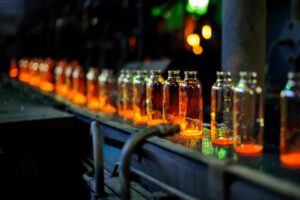This audio was created using Microsoft Azure Speech Services
June 1st, 1978, was the first time I saw how a glass bottle was made, and it made a significant impression on me. At the time, my colleagues at Vereenigde Glasfabrieken told me that if I stayed for one year and still enjoyed the industry, I would likely stay in it for the rest of my life.
Today, after 44 years, they were right. I am still busy in the glass industry and haven’t regretted it for a moment. I’ve learned that influencing the landscape of decarbonizing the glass industry became blurred by different technical problems and competition, politics, and lobbies.
Green glass – Two important questions to ask
In early 2016 Glass Worldwide magazine (Issue 66) published my first article on CO2. In early 2017 Heineken urged the packaging material suppliers to lower their carbon footprint. In April 2018, Schneider-Electric hosted the “How to face the technological challenges of the Paris climate agreement?” seminar at Marktheidenfeld, Germany. Early that year, I presented at FEVE, the Federation of European manufacturers of glass containers, a presentation on the electrification of the glass industry. With that, we became deeply involved in CO2-free glass making and started participating in customer and institute discussions about introducing an innovative container glass furnace running primarily on electrical power.
Many discussions followed, and Ardagh was appointed to build the first what was called “furnace for the future” at Obernkirchen, Germany. When I asked why that furnace would be installed in Germany, which carries a relatively high kWh price, the answer was that it is the only facility in their group with sufficient space, and the utilities can provide sufficient electrical power.
This perhaps underlines the most significant problem: policies tend to push forward instead of listening first, but in their urgency, they forget two basic questions:
- How to get the required energy into the factories?
- How to ensure long-term profitability?
The lobby provided an oversimplified answer to use electrification or hydrogen (H2) instead of natural gas or oil. Meaning, replace natural gas in pipelines with H2 or adding electrical boosting into the glass furnaces.
These are great ideas, if we forget about the physic of H2 and electrical power.
Instead, we must consider the impact H2 combustion and electrical heating will have on glass production:
- Melting process
- Refractory material
- Energy efficiency
- Safety
- Nitrogen Oxide (NOx) emissions
Further:
- What will one m3 H2 or a kWh cost?
- Where will it come from?
- How will it keep us independent of politically unstable regions?
To answer these questions requires objective help and advice.
How to move towards sustainable glass production
Meanwhile, our institutes like HVG-DGG, Glasstrend, ICG, GMIC, and many more are trying to determine the technical impact electrical heating and H2 firing will have on our melting processes.
I am sure we will find all the answers to the technical problems a switch towards alternative energy sources will cause. However, I am not as confident that politics will find commercially feasible green energy solutions or provide the necessary, affordable, timely, and correct electrical and/or hydrogen infrastructure to keep glass manufacturers in business.
Today, Schneider Electric knows that green electrical energy is and will stay the cleanest and most energy-efficient energy source for glass manufacturing, even if it is converted into hydrogen by electrolyzes first.
In glass manufacturing, electrical power in glass melting applications can be almost twice as energy-efficient as hydrogen combustion. Beyond that, “electrification and digitization” is our middle name! So let’s stay focused and targeted on what we know best, and our common sense, objective research, and working together will be the way to success, as it always was.
In that spirit, I am proud of being again part of the “green glass” team and its initiatives to help our customers to decarbonize by electrification and digitization.




